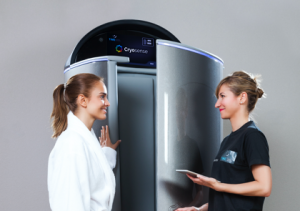Cold Water Immersion or Whole-Body Cryotherapy

· Frequency
The effectiveness of WBC depends on the frequency of exposure. A plan of 20 consecutive sessions is the minimum for effectiveness evaluation.
A study was done on 45 healthy men, divided into three groups based on the number of sessions each had to undergo. Subjected to 5, 10, or 20 sessions, each one 3-minutes long at a temperature of -130°C. Blood was collected for analysis before the sessions and upon completion of the study, as well as two weeks after that, for the examination of any long-term effects. The results showed that in response to cryo-stimulation, the level of anti-inflammatory cytokines IL-6 and IL-10 increased while levels of Il-1α cytokine decreased. It seems that the most advantageous sequence was the series of 20 cryo-stimulations. This group had the longest-lasting effects of stimulation after the completion of the whole series of treatments. In conclusion, 30 sessions should be ideal, taking into account the possibility of a complete hematological and immunological recovery after the initial response (19).
· Cold Water Immersion & Whole-Body Cryotherapy
Cold water immersion (CWI) is an immersion of the body into cold water (≤15˚C) immediately after exercise. Immersion times range from 1-15 minutes. A 2016 systematic review of the current research has identified that durations of between 11-15 minutes provides the best results for cold water immersion. It takes approximately 10-minutes for the movement of interstitial-intravascular fluid (fluid in tissues and blood vessels) to occur, suggesting that immersion should be of at least 10-minutes in order to optimize the effects of recovery.
CWI causes vasoconstriction, leading to lower localized blood flow. Reduction in blood flow around the damaged tissues, caused by strenuous exercise, reduces oedemas, and inflammatory activity.
Decreased pain or reduced perception of pain is due to the analgesic effect of the cold water. Whereby the immersion into cold water leads to decreased nerve conduction speeds and excitability, thus reducing communication with the sympathetic nervous system (flight or fight response).
A decrease in the perception of pain is related to reduced inflammatory pathways by reduced pain receptors activity, reduced exercise-induced swelling, and reduced white blood cell access (pro-inflammation response).
Both CWI and WBC are capable of relieving pain and soreness, lessening inflammation, and improving recovery. In the case of CWI, water is a better conductor for cold than the dry gas method of WBC, meaning that the sensation of coldness in CWI is more potent but can also be more painful, whereas WBC at most offers slight discomfort. Additionally, CWI poses the risk of contracting hypothermia, of which there is no risk for WBC.
CWI also requires more wait time before subsequent training sessions. A period of 12-24 hours is recommended post-CWI before engaging in exercise. In the case of WBC, exercise or training can be done immediately after treatment.
CWI also has the potential to do damage to the skin and hinder the immune system, while WBC does not; in fact, WBC is recommended for strengthening immunity.